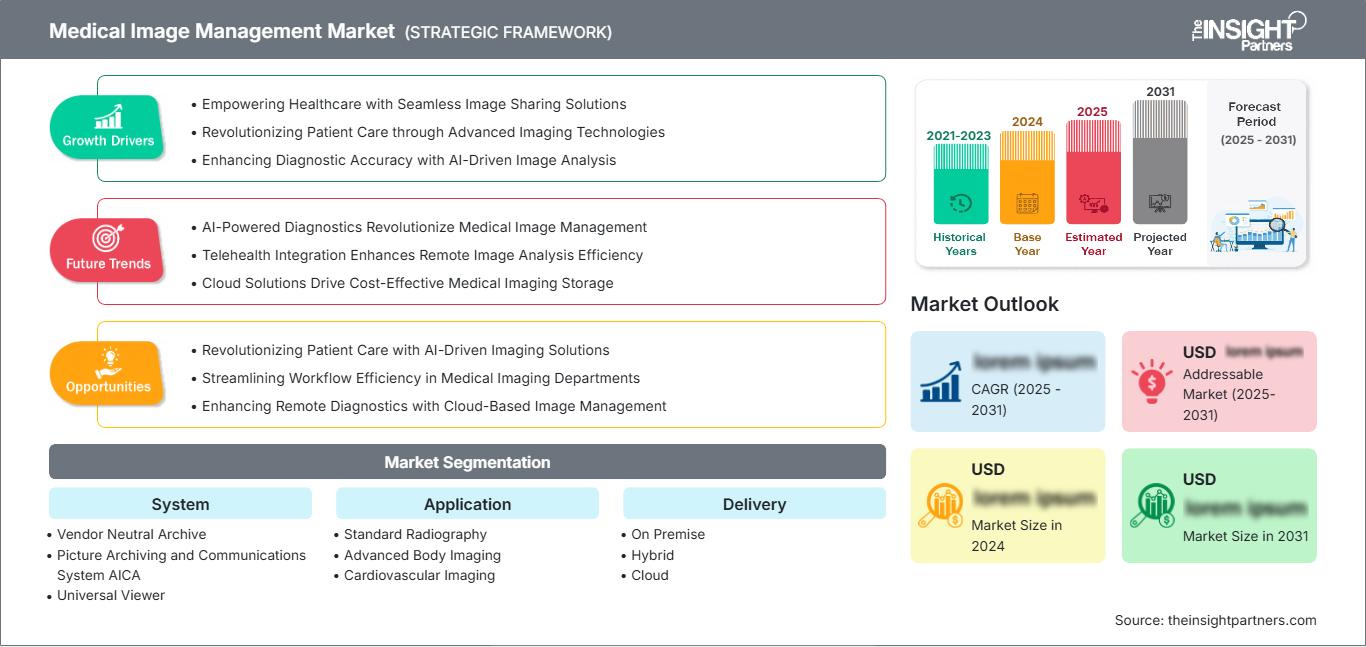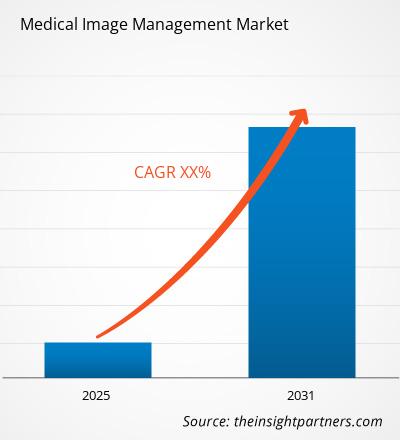Si prevede che il mercato della gestione delle immagini mediche raggiungerà gli 8,18 miliardi di dollari entro il 2031. Si prevede che il mercato registrerà un CAGR del 7,5% nel periodo 2025-2031.
Il rapporto è suddiviso in base al sistema (archivio neutrale del fornitore, sistema di archiviazione e comunicazione delle immagini AICA, Universal Viewer) e analizza ulteriormente il mercato in base all'applicazione (radiografia standard, imaging corporeo avanzato, imaging cardiovascolare, neuroradiologia, imaging muscoloscheletrico e gestione del dolore, imaging oncologico, altre applicazioni). Esamina inoltre il mercato in base alla distribuzione (on premise, ibrido, cloud) e all'utente finale del settore (ospedali, cliniche, centri diagnostici, centri chirurgici ambulatoriali). Per ciascuno di questi segmenti chiave viene fornita una ripartizione completa a livello globale, regionale e nazionale. Il rapporto include le dimensioni del mercato e le previsioni per tutti i segmenti, presentando i valori in dollari statunitensi. Fornisce inoltre statistiche chiave sullo stato attuale del mercato dei principali attori, insieme ad approfondimenti sulle tendenze prevalenti e sulle opportunità emergenti.
Scopo del rapporto
Il rapporto Medical Image Management Market di The Insight Partners mira a descrivere il panorama attuale e la crescita futura, i principali fattori trainanti, le sfide e le opportunità. Ciò fornirà spunti a vari stakeholder aziendali, come:
- Fornitori/Produttori di tecnologia: per comprendere le dinamiche di mercato in evoluzione e conoscere le potenziali opportunità di crescita, consentendo loro di prendere decisioni strategiche informate.
- Investitori: per condurre un'analisi completa delle tendenze in merito al tasso di crescita del mercato, alle proiezioni finanziarie di mercato e alle opportunità esistenti lungo la catena del valore.
- Enti di regolamentazione: per regolamentare le politiche e le attività di controllo sul mercato con l'obiettivo di ridurre al minimo gli abusi, preservare la fiducia degli investitori e sostenere l'integrità e la stabilità del mercato.
Sistema di segmentazione del mercato per la gestione delle immagini mediche
- Archivio neutrale rispetto al fornitore
- Sistema di archiviazione e comunicazione delle immagini AICA
- Visualizzatore universale
Applicazione
- Radiografia standard
- Imaging corporeo avanzato
- Imaging cardiovascolare
- Neuroradiologia
- Imaging muscoloscheletrico e gestione del dolore
- Imaging oncologico
- Altre applicazioni
Consegna
- In sede
- Ibrido
- Cloud
Utente finale
- Ospedali
- Cliniche
- Centri diagnostici
- Centri chirurgici ambulatoriali
Potrai personalizzare gratuitamente qualsiasi rapporto, comprese parti di questo rapporto, o analisi a livello di paese, pacchetto dati Excel, oltre a usufruire di grandi offerte e sconti per start-up e università
Mercato della gestione delle immagini mediche: Approfondimenti strategici

- Ottieni le principali tendenze chiave del mercato di questo rapporto.Questo campione GRATUITO includerà l'analisi dei dati, che vanno dalle tendenze di mercato alle stime e alle previsioni.
Fattori di crescita del mercato della gestione delle immagini mediche
- Potenziare l'assistenza sanitaria con soluzioni di condivisione delle immagini senza interruzioni
- Rivoluzionare l'assistenza ai pazienti attraverso tecnologie di imaging avanzate
- Migliorare l'accuratezza diagnostica con l'analisi delle immagini basata sull'intelligenza artificiale
Tendenze future del mercato della gestione delle immagini mediche
- La diagnostica basata sull'intelligenza artificiale rivoluziona la gestione delle immagini mediche
- L'integrazione della telemedicina migliora l'efficienza dell'analisi delle immagini remote
- Le soluzioni cloud consentono un'archiviazione conveniente delle immagini mediche
Opportunità di mercato della gestione delle immagini mediche
- Rivoluzionare l'assistenza ai pazienti con soluzioni di imaging basate sull'intelligenza artificiale
- Semplificare l'efficienza del flusso di lavoro nei reparti di imaging medico
- Migliorare la diagnostica remota con l'imaging basato su cloud Gestione
Mercato della gestione delle immagini mediche
Le tendenze regionali e i fattori che influenzano il mercato della gestione delle immagini mediche durante il periodo di previsione sono stati ampiamente spiegati dagli analisti di The Insight Partners. Questa sezione illustra anche i segmenti e la geografia del mercato della gestione delle malattie del ritmo cardiaco in Nord America, Europa, Asia-Pacifico, Medio Oriente e Africa, America meridionale e centrale.
Ambito del rapporto di mercato sulla gestione delle immagini mediche
| Attributo del rapporto | Dettagli |
|---|---|
| Dimensioni del mercato in 2024 | US$ XX Billion |
| Dimensioni del mercato per 2031 | US$ 8.18 Billion |
| CAGR globale (2025 - 2031) | 7.5% |
| Dati storici | 2021-2023 |
| Periodo di previsione | 2025-2031 |
| Segmenti coperti |
By Sistema
|
| Regioni e paesi coperti | Nord America
|
| Leader di mercato e profili aziendali chiave |
|
Densità degli operatori del mercato della gestione delle immagini mediche: comprendere il suo impatto sulle dinamiche aziendali
Il mercato della gestione delle immagini mediche è in rapida crescita, trainato dalla crescente domanda degli utenti finali, dovuta a fattori quali l'evoluzione delle preferenze dei consumatori, i progressi tecnologici e una maggiore consapevolezza dei vantaggi dei prodotti. Con l'aumento della domanda, le aziende stanno ampliando la propria offerta, innovando per soddisfare le esigenze dei consumatori e sfruttando le tendenze emergenti, alimentando ulteriormente la crescita del mercato.

- Ottieni il Mercato della gestione delle immagini mediche Panoramica dei principali attori chiave
Punti di forza
- Copertura completa: il rapporto analizza in modo esaustivo prodotti, servizi, tipologie e utenti finali del mercato della gestione delle immagini mediche, offrendo una panoramica olistica.
- Analisi degli esperti: il rapporto è redatto sulla base della conoscenza approfondita di esperti e analisti del settore.
- Informazioni aggiornate: il rapporto garantisce la pertinenza aziendale grazie alla copertura di informazioni e tendenze dei dati recenti.
- Opzioni di personalizzazione: questo rapporto può essere personalizzato per soddisfare le esigenze specifiche del cliente e adattarsi in modo appropriato alle strategie aziendali.
Il rapporto di ricerca sul mercato della gestione delle immagini mediche può quindi contribuire a guidare il percorso di decodificazione e comprensione dello scenario del settore e delle prospettive di crescita. Sebbene possano esserci alcune valide preoccupazioni, i vantaggi complessivi di questo rapporto tendono a superare gli svantaggi.
- Analisi storica (2 anni), anno base, previsione (7 anni) con CAGR
- Analisi PEST e SWOT
- Valore/volume delle dimensioni del mercato - Globale, Regionale, Nazionale
- Industria e panorama competitivo
- Set di dati Excel
Report recenti
Rapporti correlati
Testimonianze
Motivo dell'acquisto
- Processo decisionale informato
- Comprensione delle dinamiche di mercato
- Analisi competitiva
- Analisi dei clienti
- Previsioni di mercato
- Mitigazione del rischio
- Pianificazione strategica
- Giustificazione degli investimenti
- Identificazione dei mercati emergenti
- Miglioramento delle strategie di marketing
- Aumento dell'efficienza operativa
- Allineamento alle tendenze normative




















 Ottieni un campione gratuito per - Mercato della gestione delle immagini mediche
Ottieni un campione gratuito per - Mercato della gestione delle immagini mediche